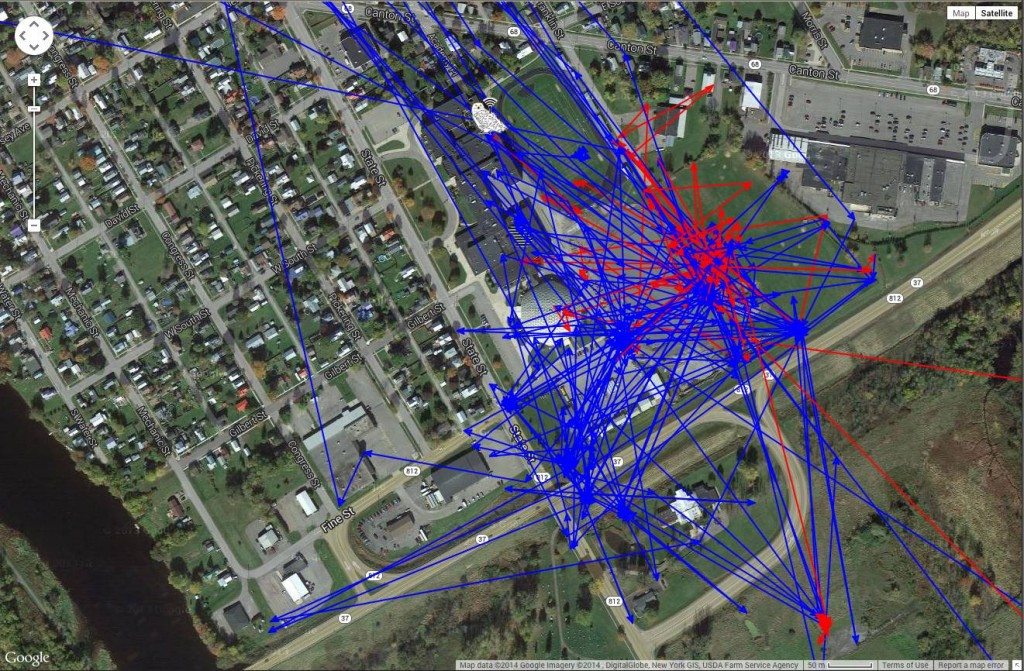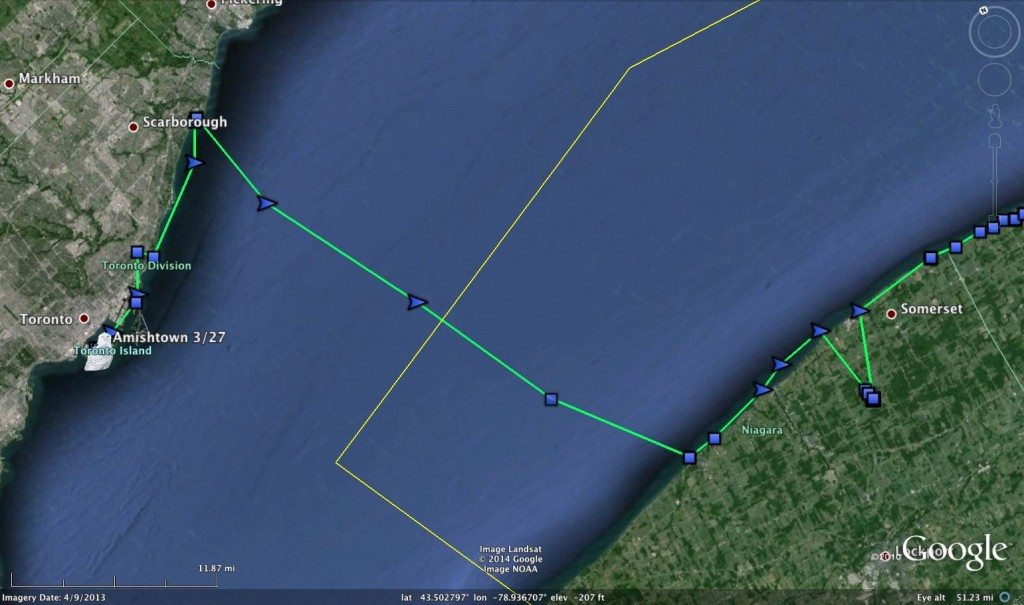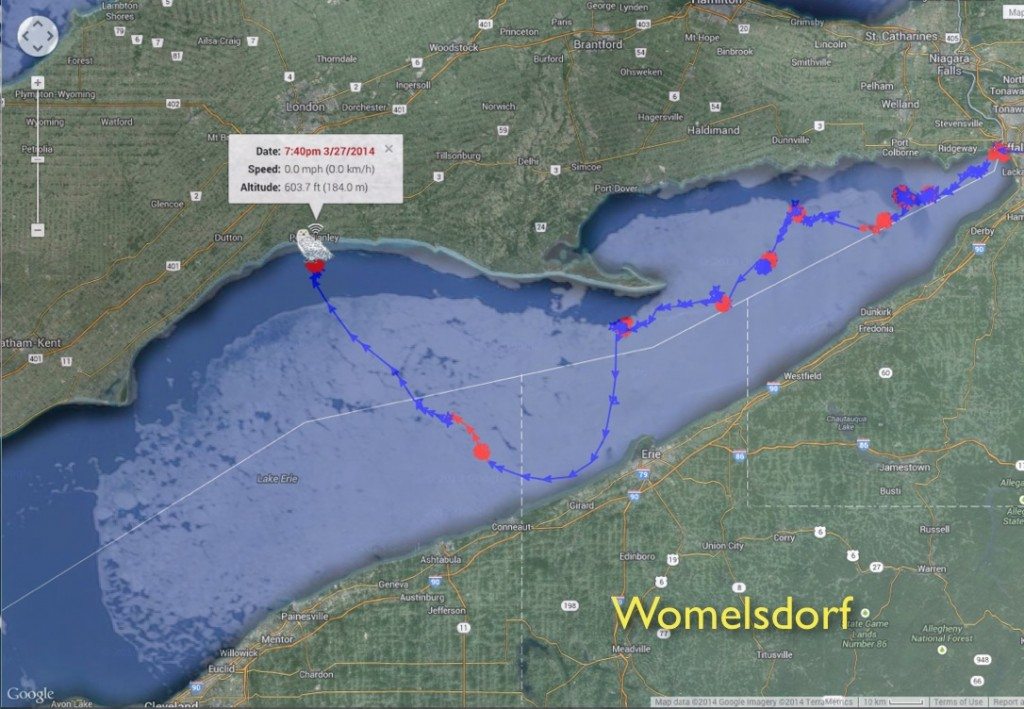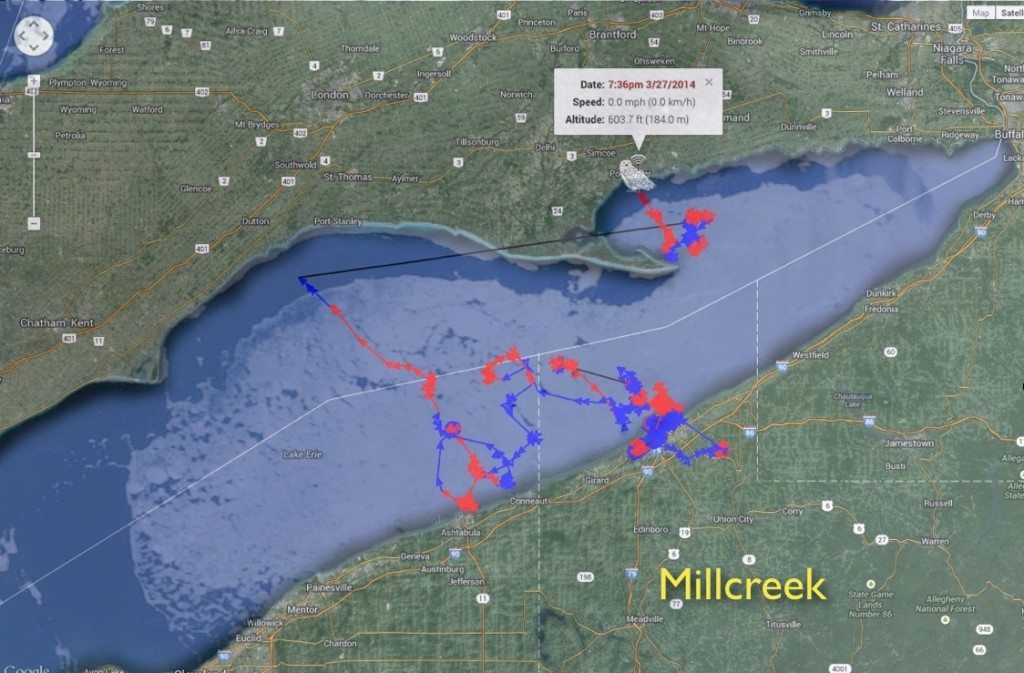
Oswegatchie is obviously a big fan of the Ogdensburg Free Academy “Blue Devils.” ((©Project SNOWstorm and Google Earth)
The last few updates we’ve been focusing on the owls that are moving the most, so I thought I’d start today’s update, based on our March 27 transmissions, with the snowy that is moving the least — Oswegatchie, in upstate New York along the St. Lawrence River.
Since he was tagged March 8, he has barely stirred from the town of Ogdensburg. A couple of weeks ago he made one short hop of about 10 miles across the river into Canada, spent a day and came back. Since then, Oswegatchie has spent almost all of his time in town, especially near the Ogdensburg Free Academy, the town’s high school with its locally famous Golden Dome arena, on the huge, rounded roof of which he frequently perches.
This time he made a short sojourn outside of town to the local airport — always a worrying behavior, given how badly planes and owls mix — but then he headed back to the high school area.
Speaking of stay-at-homes, Plum continued to hang close to the Marblehead Peninsula and Salem, Mass., area, including some of the offshore islands and ledges like Great Haste Island (she hasn’t returned to Satan Rock — an appropriate name, given Salem’s witch-trial past — since stopping there March 19).
Probably because of a cold, northerly airflow during the period, we didn’t see many signs of significant migration this time. After making a quick flight across southern New England, Century lingered in eastern New York, moving about 25 miles between Saratoga Lake and Great Sacandaga Lake, where it spent two days before heading back to Saratoga.
In both cases, the owl was using the frozen lakes for resting and hunting, and its commuting flights between them were fairly low-elevation — but fast. Century doesn’t mess around; even her flights up and down Great Sacandaga averaged about 20 knots (23 mph — the transmitter record flight speed in knots), which is much faster than the usual 6-10 knot speed we see in local flights.

Amishtown’s 35-mile flight across Lake Ontario the night of March 26-27. (©Project SNOWstorm and Google Earth)
One owl that did make a marked northward flight was Amishtown. Having stopped west of Rochester in Braddock and Cranberry’s old stomping ground, he flew across the western end of Lake Ontario, making the 35-mile trip in about two hours, with at least one rest stop along the way on ice. By dusk on the evening of the 27th he was on Toronto Island, just offshore of Toronto proper.
Wiconisco remained in Wyoming County, New York, about 30 miles east of Buffalo, where he’s been since making a rapid flight from central Pennsylvania.
The most active owl in this period was Womelsdorf, who flew 122 miles around Lake Erie, from east of Long Point, south almost to Presque Isle, then across the lake to just a few miles from the Ontario shore near Port Stanley. It’s a very similar track to one made by Millcreek a couple of weeks ago — but that owl is now east of Long Point.

Womelsdorf’s 122-mile flight around Lake Erie, often spending his days at the edge of the ice sheets. (©Project SNOWstorm and Google Earth; MODIS ice imagery by NOAA CoastWatch )
I’ve overlayed the most recent satellite image (March 30) of ice on Lake Erie with the tracks for both of these owls, and the results are fascinating — especially the way Womelsdorf (above) moved several times to the ice edge to hang out during the day. The pattern is less obvious with Millcreek (below), but remember his on-ice track spans more than a month, and the ice conditions (especially the location of cracks) has changed repeatedly because of prevailing winds during that period.

Millcreek’s on-ice movements this winter. (©Project SNOWstorm and Google Earth; MODIS ice imagery by NOAA CoastWatch )
Other updates: Erie remains in eastern Michigan, pretty much where he was last time. Braddock didn’t check in this time after his major flight up and down Georgian Bay; he’s probably just out of cell range. Hungerford checked in, still just north of Cape May, NJ, near Stone Harbor and Avalon, while Monocacy’s transmitter continues to collect a torrent of data at 30-second intervals as she patrols the neighborhoods of urban Baltimore.
Marshfield remains near Chippewa Falls, WI, and Kewaunee hasn’t done more than make a few local flights from his wintering territory just west of Lake Michigan. Ramsey hasn’t checked in for two cycles, having moved about 65 miles southwest of his wintering site in Ramsey, MN. I’ve been looking at cell-coverage maps, and this area of farm country seems to have spotty coverage at best.
Buena Vista checked in a couple of times in the past week — more erratically than we’d like, but we’ve built up a terrific data set of locations for him since last December. Freedom, along with several other owls (Assateague, Duxbury, Cranberry and Henlopen among them) did not check in. We continue to be hopeful, but this is a dangerous time of the year for snowy owls, especially young ones like this season’s crop — once they start moving into new locations they often get into trouble.


10 Comments on “March 27 transmission update”
How is Sandyneck & Duxbury doing?
This initiative has been very impressive and informative. Thanks so much for your efforts. I am in north-central Illinois and have been monitoring what appear to be three snowy owls in southeastern Boone county, IL since mid-January. Others might like to know that a Google My Places map can be made to keep track of sightings by date. My effort can be seen at http://goo.gl/maps/pjuHr Some of my Snowy Owl photos for these sightings can be seen on Flickr at http://flic.kr/ps/xUCPt
Could you elaborate on some of the expected “trouble” that the younger owls get onto when they start heading north.
Thank you for your work with the owls and your sharing of the fascinating data that you are collecting . Most interesting and educational. Marie
The biggest problems are vehicle and plane collisions; an owl we banded (but did not tag) last month in Maryland wound up hit by a plane at Philadelphia last week — it had moved into a new place full of dangers it wasn’t used to. Another snowy that one of our collaborators banded in December in Pennsylvania was hit by a car and killed. But we’ve seen owls that have been blasted by heat vents on buildings or methane flares on landfills, that consumed poisoned rodents, been electrocuted by high-tension lines, collided with wires or become trapped inside buildings and other structures. Norman Smith at Mass Audubon, who has been studying snowy owls longer than just about anyone in the country, was telling me this morning that, based on his previous banding and tracking work, the northbound period is the most dangerous for snowy owls — and of course the most tragic, because these are birds that almost made it through the winter. But we have to remember that almost all the snowy owls in this winter’s irruption are young birds hatched last summer, making their first migration — a dangerous period for any animal, when the mistakes of youth can have fatal consequences.
Thanks for the expanded info on the perils that the owls face during migration – I never thought of some of those you mentioned. Nature presents enough then we add the man made ones – making their journey even more of a challenge.
Hello Everyone,
I reside on the Northern end of Plum Island Mass, where I had a chance to view “one” either Plum and or Century hunting in my dune last week, they where feeding on Ducks mostly… I noticed the transmitter and notified a friend in return my pal spoke to Norm the gentlemen who relocates the Logan Birds… Amazing Job folks for everything you have accomplished
Great Job
David
really greatly appreciate all the detail you give us…i know how time-consuming it must. once more, thanx.
Thanks for all your time and effort.. This is great to watch the migration back north.. I have also in pass years watched east coast golden eagles migration north to the Hudson Bay and beyond… I live in Sheffield Pa. about 70 miles east of Erie Pa. I took pictures of two of the snowy owls on Presque Isle, and the one just south of Jamestown New York….
Ramsey had moved to an area that was inhabited by another snowy this winter. The area that he moved to is quite rural, and you are correct, has dicey cell phone coverage. If he hasn’t checked in by the end of the week, i’d be happy to go out there and snoop around a bit for him, and talk with some farmers to see if they’ve encountered him.
How is Duxbury doing?